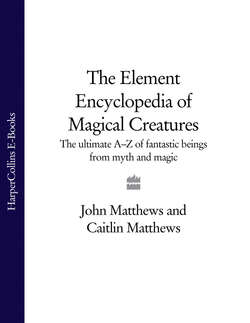Читать книгу The Element Encyclopedia of Magical Creatures: The Ultimate A–Z of Fantastic Beings from Myth and Magic - John Matthews - Страница 12
Monsters and the Role of the Monstrous
ОглавлениеSome of the creatures appearing in this collection are what many would call monsters. But what makes a monster? A monster is seen to be any creature that deviates from the norm. Grotesque variations of the familiar are abhorrent and scary, as we understand when we view any unfortunate person born with a physical abnormality. We feel pity and compassion, but we are also greatly unsettled. But genetic malformations are in a different category to the true monster. Monsters are not one-off creatures; while they may make solitary appearances, they are actually legion.
Leonardo da Vinci wrote about the creation of imaginary animals,
‘You cannot make any such animal without making its limbs bear some resemblance to those of other animals. If you want your dragon to look natural, then take the head of a mastiff or setter, the eyes of a cat, the ears of a porcupine, the nose of a greyhound, the eyebrows of a lion, the crest of an old cock and the neck of a turtle.’
It is this very likeness to the normal that skews our perception and aesthetic values, giving us the sense of the monstrous.
Monsters have the ability to show the unspoken or unexpressed. Indeed, that is what the word ‘monster’ derives from – a ‘showing’, ‘omen’ or ‘miracle’. What we do not care to look at too closely, and what we gloss over in our own behaviour, is expressed by the monster who reflects our shadow. Indeed, cultures worldwide expressly use the monstrous as a threshold guardian of control, drawing on primordial or cultural monsters to patrol the limits as bogeymen. And fear is the bogeyman’s chief weapon of control.
Any study of magical creatures shows how, with certain exceptions, some of them are automatically seen as monstrous by the Christian world, animals that symbolize evil, emanating from the devil, helping to oppose the lawful order of things. Monsters infest places, destroy crops, waste the land, persecute human inhabitants and threaten life itself. As Jacqueline Borsje writes,
‘Monsters originally represent nonmoral evil, the powers of Chaos. As Christian influence on the texts increases they seem to attain an extra dimension…they also begin to personify moral evil.’
But this is not the primal function of monsters. They are not intrinsically or morally evil in themselves. They have another function.
We may see just how the idea of monsters and the monstrous has continued to invoke a deep response if we consider two of the seminal works of 19th-century fiction: Frankenstein by Mary Shelley and Dr Jekyll and Mr Hyde by Robert Louis Stevenson. Both are deeply rooted in the idea of the monstrous other, the aspect of nature that is not of us and therefore horrific. Each makes it clear that to create and let loose the monster within is every bit as terrifying as an encounter with a Black Dog or Dragon.
Monsters as agents of the primal chaos of creation underlie many world myths. Thus, we find Tiamat and her family in Assyrian myth, the Titans of Greek myth, the giants and primeval monsters of Celtic, Polynesian and Australian myth. Without these monsters, there would be no earth, no seas, no rivers, no mountains. These titanic beings are world-shapers who live just below the surface of our imagination. Their function is to watch the by-ways and borders of the ordered world, threatening it with chaos, challenging its fixity with a shimmering power, ensuring that the civilized order is kept flexible and permeable to the changing influences of a creative power that has not yet ceased to flow. Monsters can therefore be seen as guardians of creative power whose purpose is to challenge the self-complacency of the seemingly changeless order that we so like to inhabit. Monsters bring out our heroic side, making us draw deep upon our own animal resourcefulness.
Back in pre-Christian myth, the slaying of the monster is a heroic task necessary to keep safe the boundaries of ordinary living. But while too much chaos can swamp us, too much certainty can also bring life to a dead end. In that perpetual shimmer of contact between our world and the world of monsters is an invisible gateway, an edge of excitement that incites us to quest, adventure and balance. Primarily, monsters help us maintain the balance of the universe.
